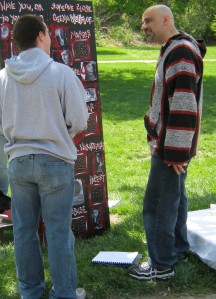
Disability and the Church, Lamar Hardwick, foreword by Bill Gaventa. Downers Grove: IVP Praxis, 2021.
Summary: An eloquent and theologically grounded plea affirming the value of persons with disabilities and the steps churches can take to welcome and fully include them.
It was heart-breaking. Friends with a son who has a developmental disability were asked by an usher to leave a service due to the fact that their son’s vocalizations were distracting to others. Their son was fully aware he was the reason they were asked to leave. A well-stated letter to the church’s vestry (and social media posting) led to further meetings and a welcome to return.
Many of our churches post signs that say “all are welcome” and make efforts to welcome those of various ages, economic status, ethnicity, and gender and sexual orientation to our congregations. Yet both physical barriers and barriers of perception, understanding and values make it difficult for persons with disabilities to find welcome and be accepted as valued parts of our church communities. The U.S. Center for Disease Control states that 61 million adults (or one in four) in the U.S., a number that rises to two in five over the age of 65.
Lamar Hardwick is a Black pastor with a passion for reaching this huge population. A significant part of this is fed by his growing understanding of his own autistic spectrum diagnosis at age 36. He describes both the wonderful ways his congregation made accommodations informed by his diagnosis as well as some of the responses that sought to persuade him not to talk about his diagnosis. Thankfully, he and his congregation have learned to live with his disability in ways that allow his gifts to flourish. This book both narrates some of that journey and discusses a theology of persons with disabilities that affirm their unique gifts and abilities and capacity to contribute in our communities.
He grounds this appeal in the reconciling work of Christ, our unity and individuality in Christ, and his peace in our communities. He believes that the church is made for inclusion, including inclusion of those with disabilities. He then begins to address specifics of inclusion by contending that we have not designed our churches for inclusion of persons with disabilities. We need to think about what it means to set a table that is welcoming in terms of staff, background checks, training, equipment, curriculum, family support, special events, and outreach and marketing.
As we work with the disabled Hardwick draws on his own experience to discuss better questions: not, “why did this happen?” but “how may God be seen?” He deals with efforts to “heal” those with disabilities which may reflect our own discomfort with suffering when we might better walk alongside a person as God forms them through their disability. Hardwick explores the barriers of body image in our culture and how we respond to those who fall outside “ableist” norms. He raises the intriguing question of whether the risen Lord, bearing the wounds of the cross, would also bear their disabilities in the use of his hands, and his abilities to walk. We have to consider whether our actions help or hurt and we cannot do this apart from those with disabilities being part of the conversation.
Then drawing a parallel with the parable of the soils and the three soils that do not bear fruit, he addresses three kinds of barriers that hinder our churches from bearing fruit in including those with disabilities. There is the barrier of lack of understanding that may be met with education. Second is the barrier of life’s problems that prevent those with special needs from making deep and meaningful connections addressed through patient and persistent care and appropriate support structures. The third is the barrier of thorns, by which Hardwick means the policies, processes, and programs that hinder the fruitful engagement of those with various disabilities. He believes this is addressed by developing a diverse leadership culture that includes those with disabilities and affirms their leadership.
Above all, he commends the development of an affirmative culture focused on what all those with disabilities are able to do in all areas of church life. What makes this book so compelling is that throughout, Hardwick is not simply advocating for those with disabilities, but with them, speaking out of his own experience, and offering a vision of what could be as the church awakens to this significant “people group” who we often fail to include well.
____________________________
Disclosure of Material Connection: I received a complimentary review copy of this book from the publisher in exchange for an honest review. The opinions I have expressed are my own.
 I recently wrote a post on “
I recently wrote a post on “